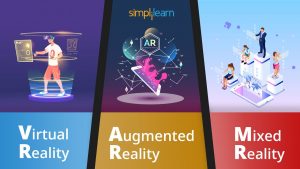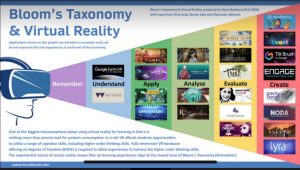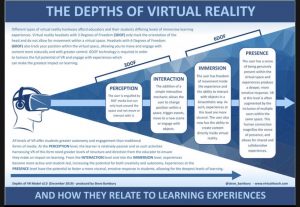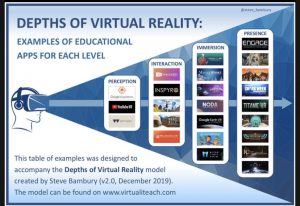AR VR MR – Week 12
First off, what is Augmented, Virtual and Mixed Reality?! If you are anything like me, someone who has limited knowledge on any of these realities, you also would have appreciated this week’s presentation on the topic. Matt, Kim and Brian did a great job putting their content in a way that a novice like me can understand!
Matt, Kim and Brian illustrated the importance of distinguishing the difference between these three terms to completely understand them. Augmented Reality as outlined during this week’s  presentations is where digital content is superimposed (pictures, text, animations, 3D models, etc) over the real world, instead of blocking out the world it supplements which will allow the user to experience both at the same time. Virtual Reality is the concept that we are most likely to know the most about. VR is a computer generated that completely immerses the user and blocks out the real world. Mixed Reality blends components of augmented and virtual reality that allows its users to interact with and manipulate objects that are overlaid on their real world setting.
presentations is where digital content is superimposed (pictures, text, animations, 3D models, etc) over the real world, instead of blocking out the world it supplements which will allow the user to experience both at the same time. Virtual Reality is the concept that we are most likely to know the most about. VR is a computer generated that completely immerses the user and blocks out the real world. Mixed Reality blends components of augmented and virtual reality that allows its users to interact with and manipulate objects that are overlaid on their real world setting.
AR, VR, MR & Education
So how do these 3 realities play into the world of education? It was outlined to us that they can be utilized to create an immersive learning environment for students which can also provide opportunities for teachers to give their students experiences that they may not be able to depending upon resources that are available to them in their classrooms or within their schools. For example, you are able to provide students an experience working in a mechanics shop when your school does not have one or you could use the realities to take your students inside the human body during a Science or Biology lesson.
 It was discussed during this week’s presentation that VR fits within Bloom’s Taxonomy of Learning components. Brian displayed an image that was created by Steve Bambury (2020) outlining how VR fits into Bloom’s Taxonomy of Learning and help create an immersive experiential learning environment.
It was discussed during this week’s presentation that VR fits within Bloom’s Taxonomy of Learning components. Brian displayed an image that was created by Steve Bambury (2020) outlining how VR fits into Bloom’s Taxonomy of Learning and help create an immersive experiential learning environment.
 I was really appreciative of the graphics that the group used this week to help us understand how VR can fit into the educational world and how our students can use it.. As outlined in the graphic below (used in presentation), there are 4 depths that VR can fall into – perception (3DOF), interaction(3DOF), immersion(6DOF) and presence(6DOF). These categories are all dependent upon the Degrees of Freedom (DOF) available to the user. When more DOF are available, a more immersive experience is the result.
I was really appreciative of the graphics that the group used this week to help us understand how VR can fit into the educational world and how our students can use it.. As outlined in the graphic below (used in presentation), there are 4 depths that VR can fall into – perception (3DOF), interaction(3DOF), immersion(6DOF) and presence(6DOF). These categories are all dependent upon the Degrees of Freedom (DOF) available to the user. When more DOF are available, a more immersive experience is the result.
We were also provided with an illustration (below) that puts some of these VR apps into the respective categories based on what type of immersive environment they create. I found this very helpful as I see this as a new avenue that I can see myself going down to bring into my classroom. I love teaching science, but specifically about the human body as it really is fascinating! I often struggle with finding experiences that can go along with lessons for Grade 7 & 8’s because our school is not equipped with a fully stocked Science lab. VR provides an alternative to give students this experiential learning opportunities that will give them a real world look.
science, but specifically about the human body as it really is fascinating! I often struggle with finding experiences that can go along with lessons for Grade 7 & 8’s because our school is not equipped with a fully stocked Science lab. VR provides an alternative to give students this experiential learning opportunities that will give them a real world look.
Human Anatomy VR App
Like stated earlier, I often struggle with creating an experience for my students in the classroom that goes along with their lesson; thinking Science, Social Studies and PAA specifically. This is where I see VR/AR/MR coming into play in my own classroom. I am lucky enough that most of my students come to school with their own personal device which I would likely utilize for this as getting the right amount of Chromebooks is a daunting task and often results in students having to share a computer. A VR app that focuses on the human body would add an element to lessons and activities that would make an impact on the students. I structure my science classes with a lesson where we go over various information and then I try to have a practical application activity for students afterwards as a reinforcement to what their learning was focused on. Being able to see within a human body without having to leave the school is a great opportunity. This exact app is a paid program that only allows for free trial for 2 hours, but if I was able to get my hands on a subscription I would utilize almost every lesson for my Human Body Unit.
AR/VR/MR & The Digital Divide
All of this technology sounds lovely, but In a world that already sees a very large technological divide based on different populations and socioeconomic statuses, I feel that these realities would create an even larger divide. These realities require specific programs, hardware, equipment and simple access to smartphones to be able to utilize – which is something that not all are privy to.
In the article, Is There Still Time to Build Equity Into Virtual Reality Edtech which is written by Rebecca Koeing, outlines that VR headsets and equipment can cost hundreds of dollars, which is a big price tag for some students who already have trouble affording an up to date computer or internet that allows them to complete their work. It is also outlined that if VR in education is not implemented in a thoughtful manner, it will only widen this already large digital divide. Others argue that VR can act as a ‘bridge’ to access to higher education opportunities with the ability to teach those students who are not able to make it into a classroom. Koeing also outlines that those groups who are often benefited from previous technological advancements could also be positively impacted by the implementation of VR.
Blogger Raghu Bathina writes in his article How to Avoid Creating the Next Digital Divide Through VR that “VR is no mere video game delivery system. It is increasingly an educational tool, entertainment vehicle, social connector, healthcare solution and training platform. It will increasingly be a part of how students learn and professionals receive important training.” He later outlines 7 ways in which he sees avoiding a new digital divide or extending the current one.
- Continue to support low-entry devices – creating and making available VR devices people can access regardless of their status or income.
- Develop Open Standards –
- Browser-based VR – these could be a great equalizer as to who can afford to engage with VR. There are many affordable computers on the market for a fraction of the cost of other devices.
- Accommodations for ALL – accommodations need to be made for those who many have hearing and visual impairments.
- Diversity, Inclusion & Equity – create opportunities for creators of color and those from other backgrounds to participate meaningfully in the VR world and ensure we build in a way that empowers people from various backgrounds to live their most authentic lives.
- Free Participation – ensuring that their are VR opportunities with local libraries, schools and school districts.
- Private Public Partnerships – Government involvement in grants for accessible distribution of VR.
Thanks for a great semester!
Cheers,
Bret
One thought on “AR VR MR – Week 12”
Awesome post, Bret! I appreciate the additional resources and will be looking into them soon. It was a huge subject to cover, and it seemed even broader when Matt, Brian, and I realized we didn’t initially have a firm grasp on the definitions and differentiation of immersive tech. Like so many, I was at first dazzled by the possibilities…but the more we researched, the more concerned I became. It will be interesting to see in the next 10 years if VR truly becomes “a bridge.” passing fad, or something more sinister.